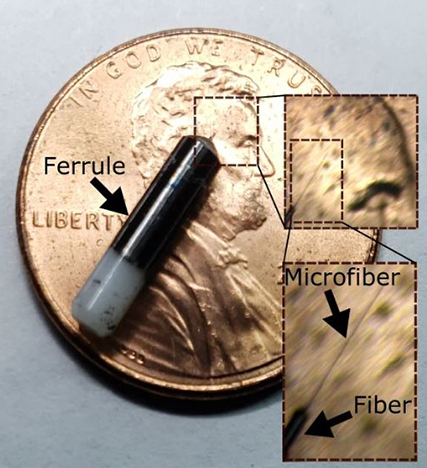Researchers at the University of California San Diego have developed a tiny neural probe that is approximately one fifth of the width of a human hair. The probe is flexible and can be implanted for extended periods without aggravating the immune system, in part because of its small and unobtrusive profile.
Its miniature size means that it may also be suitable for implantation in areas where other probes can’t fit, such as between the vertebrae and into the spinal cord. Containing an electrical channel and an optical channel, the coaxial probe can both record electrical activity from neurons and also stimulate the neurons using light. So far, the probe has shown stable performance for up to one month after the researchers implanted it into the brains of mice.
We may be on the precipice of a new age of technologies that can monitor and control our neural tissue, and the medical opportunities are enormous, from pain reduction to seizure control. However, the crux of such technologies occurs where they interact with our neurons and so neural probes are a key technological development in progressing neuromodulatory devices.
This latest example is notable for its small size, at 8-14 micrometers in diameter. To put that in perspective, a human hair is approximately five times thicker. This means it can reach areas other probes can’t, such as small peripheral nerves or even the small gap between vertebrae and into the spinal cord itself.
“This is where you’d need a really small, flexible probe that can fit in between vertebrae to interface with neurons and can bend as the spinal cord moves,” said Axel Nimmerjahn, a researcher involved in the study. “For chronic neural interfacing, you want a probe that’s stealthy, something that the body doesn’t even know is there but can still communicate with neurons,” added Donald Sirbuly, another researcher on the project.
In an engineering challenge, the researchers introduced two channels within a single probe, one to transmit electrical data from neurons to an external device and a second optical channel to transmit light, as a means to stimulate and control nearby neurons. So far, the researchers tested the probe in mice, and found that it provided stable performance for up to one month when implanted into the brain.
“Currently, we know relatively little about how the spinal cord works, how it processes information, and how its neural activity might be disrupted or impaired in certain disease conditions,” said Nimmerjahn. “It has been a technical challenge to record from this dynamic and tiny structure, and we think that our probes and future probe arrays have the unique potential to help us study the spinal cord — not just understand it on a fundamental level, but also have the ability to modulate its activity.”
Check out a video of the probe being inserted:
Study in Nature Communications: Electro-optical mechanically flexible coaxial microprobes for minimally invasive interfacing with intrinsic neural circuits
